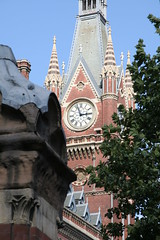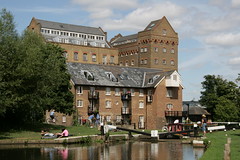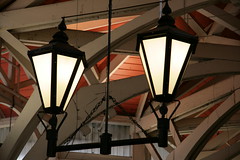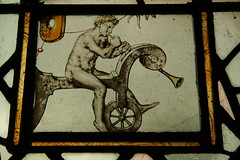 A nice ride this afternoon joining up bits of recent rides with an old favourite, for a 38 mile loop round Henley, Christmas Common, Turville, Hambleden and Marlow. After a grey morning the weather turned sunny and wam this afternoon. It was a little bit windy, but otherwise nothing to grumble about.
A nice ride this afternoon joining up bits of recent rides with an old favourite, for a 38 mile loop round Henley, Christmas Common, Turville, Hambleden and Marlow. After a grey morning the weather turned sunny and wam this afternoon. It was a little bit windy, but otherwise nothing to grumble about.Monday, 31 August 2009
Turville & Hambleden
 A nice ride this afternoon joining up bits of recent rides with an old favourite, for a 38 mile loop round Henley, Christmas Common, Turville, Hambleden and Marlow. After a grey morning the weather turned sunny and wam this afternoon. It was a little bit windy, but otherwise nothing to grumble about.
A nice ride this afternoon joining up bits of recent rides with an old favourite, for a 38 mile loop round Henley, Christmas Common, Turville, Hambleden and Marlow. After a grey morning the weather turned sunny and wam this afternoon. It was a little bit windy, but otherwise nothing to grumble about.Saturday, 29 August 2009
When possible make a U-turn
Saint Pancras
Friday, 28 August 2009
Wired
I quite like Wired, so I am hugely flattered that they chose my picture, and pleased that they have attributed it. But I'm a bit surprised that a publication like that didn't take more care over the license restrictions, which specify "non-commercial use".
I've emailed them to that effect, offering to send details of where to send payment, if only in recognition of the importance of the licensing system, and the rights of commercial photographers. I will report results.
Sunday, 23 August 2009
Arbitrary and meaningless?
Saturday, 22 August 2009
A day at Ascot
Friday, 21 August 2009
OSM coverage in Scotland and Wales
Name |Coverage
Isle of Anglesey | 124%
Gwynedd | 71%
Conwy and Denbighshire | 54%
South West Wales | 60%
Central Valleys | 43%
Gwent Valleys | 35%
Bridgend and Neath Port Talbot | 65%
Swansea | 77%
Monmouthshire and Newport | 72%
Cardiff and Vale of Glamorgan | 79%
Flintshire and Wrexham | 87%
Powys | 50%
Angus and Dundee City | 56%
Clackmannanshire and Fife | 51%
East Lothian and Midlothian | 65%
Scottish Borders | 60%
Edinburgh, City of | 99%
Falkirk | 55%
Perth & Kinross and Stirling | 66%
West Lothian | 64%
East Dunbartonshire, West Dunbartonshire and Helensburgh & Lomond | 66%
Dumfries & Galloway | 51%
East Ayrshire and North Ayrshire mainland | 42%
Glasgow City | 86%
Inverclyde, East Renfrewshire and Renfrewshire | 70%
North Lanarkshire | 55%
South Ayrshire | 48%
South Lanarkshire | 58%
Aberdeen City and Aberdeenshire | 46%
Caithness & Sutherland and Ross & Cromarty | 64% *
Inverness & Nairn and Moray, Badenoch & Strathspey | 64% *
Lochaber, Skye & Lochalsh, Arran & Cumbrae and Argyll & Bute | 64% *
Eilean Siar (Western Isles) | 67%
Orkney Islands | 29%
Shetland Islands | 48%
(*) = Average across three regions
Thursday, 20 August 2009
OSM coverage in Scotand and Wales

I've had a first attempt at measuring OSM coverage in Scotland and Wales using NUTS-3 regional boundaries as the common ground to compare Department for Transport statistics on the length of roads in a local authority against the length of roads plotted on OSM.
NUTS is the basis on which the EU publish regional statistics, and they provide the boundaries as shapefiles. The precision isn't as great as you get from admin boundaries on OSM, so this is a stop-gap until the boundaries for local authorities in Scotand and Wales are complete on OSM (or until the Ordnance Survey put them in the public domain).
On the whole the NUTS boundaries match up reasonably well with Local Authority boundaries. In some cases they are the same, in others I can aggregate the road lengths for a few authorities to get the figure for the equivalent NUTS region. It's only in the Scottish highlands where this doesn't work too well, because the local authority for the Highlands crosses several NUTS regions. So I needed to take an average across a big area of northern Scotland.
Nobody seems to like the colouring on this attempt very much, so that will need some more work. But meanwhile, the headlines are that Anglesey and Edinburgh look well covered. Glasgow, Renfrewshire, and Gwynedd look pretty good. While Powys, Aberdeenshire, Orkney and Shetland are looking a bit thin.
For anyone interested in doing a similar exercise elsewhere in Europe, I don't know what detailed figures are published at national level, but there are Eurostat figures for road lengths at the NUTS-2 level (i.e. the next largest geographical grouping after those I am using here). Eurostat only split "Motorways" and "Other Roads" so dealing with dual carriageways etc is going to be a bit iffy. However, I've done a quick comparison of their numbers for the UK, and the rough figures (motorways * 2 + other roads) gives me a total that isn't a million miles away from more detailed calculations. The Eurostat figures are here under "Regional Transport Statistics", and the Eurostat shapefiles that I used are here
There's another version, with brighter colours here
Monday, 17 August 2009
Navigation
From there to the top of the Wey Navigation is on the West London sheet (176) and I checked that one a couple of times, but along the canal itself it only took me as far as the point where the M25 crosses.
Then I was on the Dorking and Reigate sheet (187) almost until I reached Newark lock (in the picture). After that I would have been following the route on the Aldershot & Guildford sheet (186) except that I didn't have a copy of that one.
Not that it particularly matters along a canal of course. Even at my most vague and woolly, it would be quite an achievement to get lost on a towpath. Except for one thing.... approaching Guildford there are a couple of different options, and I suspect I didn't pick the best route into the centre.
Getting home from the centre of Guildford was another matter. My planning for the day had been bit sloppy to put it mildly. Basically I knew that if I headed north I would end up somewhere familiar, and I hadn't given it much more though than that. I've got the OSM cyclemap on the GPS, and since that now has route finding I was pretty relaxed about getting home.
In the event, though, the distance from Guildford to home proved a bit too much for the GPS. I fiddled around with partial routes for a while without too much luck, and in the end I realised I didn't have time to drift much off a straight line, so I went and found a book shop, and bought a copy of the local OS sheet.
That got me as far as Bagshot. Not that it needed much checking since I was now following a main road, with plenty of signposts. From Bagshot I was back on the OS sheet that I had started from, but more importantly, I was on familiar ground, and the GPS route finder was coping, and ticking down the remaining distance. So from Bracknell I was able to call home and let them know (more or less) exactly how late I was going to be.
Unfortunately slippy maps on the internet don't function too well out on the road. The GPS is wonderful, but it isn't really up to finding 20 mile routes on the bike yet (though it is getting there). I am trying to make a convincing case to myself that an Internet tablet with GPS and Maemo Mapper would be just the thing (without much luck). So in reality I suspect that I'm going to be carrying bundles of landranger maps for a while yet.
It seems a bit ironic that all this came to the fore along a canal route call the "navigation".
Sunday, 16 August 2009
Wey to go
I had reached Weybridge along the Thames path, and I returned home from Guildford with a dash up the A322; trying (unsuccessfully) to get home in time for dinner.
I'm fairly clear now about my preferred route to Weybridge. There was a slight glitch in Staines today because they had closed off the Thames path for some reason, so a bunch of us on bikes diverted through the town centre. Apart from that all was straightforward to the ferry at Shepperton, then the fun of taking the bike across the river to Weybridge.
From the ferry I had to hunt out the point where the Wey Navigation leaves the Thames and heads off for Guildford. It didn't look entirely clear on the map, but in practice it wasn't difficult to find.
The navigation is a very early canal, that now belongs to the National Trust. It was built in 1650, and runs from Weybridge to Guildford. An extension to Godalming was added about a hundred years later.
The towpath is quite narrow, and bumpy, and today it was quite busy, so progress was a bit slow. They allow bikes, but I'm not sure they actively encourage them, because of the number of walkers. I would recommend it - though it's probably a better ride on a mountain bike than a road bike. My hybrid and I coped, but neither of us was really designed for this.
Today was a beautiful, day, and its a lovely ride. There is the occasional point of interest, including a view of a ruined priory; this old mill converted into flats; and some fancy graffiti under the motorway.
The only trouble with the route is that I ended up in Guildford. Not that I have anything against Guildford - it seems a very pleasant town, with quite an impressive high street. The trouble is that I don't know a decent route home from there. Today I just belted up the A322, which is a very indifferent experience. Perhaps I'll figure out something better in future.
By the time I got home I had covered 64 miles. That brings my Eddington number up to 40; and this bike and I have covered over 5,000 miles together. From today, I'll try to forget the return journey, and remember the navigation.
Thursday, 13 August 2009
Planet Hannan
Reality check. We used the NHS yesterday - my father-in-law had an operation on his eye that seems to have been successful.
Wednesday, 12 August 2009
Choropleth
Rush hour fun
Tuesday, 11 August 2009
More on OSM coverage

I've been doing more work on trying to estimate the level of OSM coverage in different parts of the UK by comparing the length of roads in the database with statistics for each local authority published by the Department for Transport. Since my first attempt there have been several improvements. Not least in the number of local authority boundaries for England that are available in the OSM database. It's now pretty much a complete set for the upper-tier authorities in England. Some district councils are still missing, but I can't use those anyway because the DfT statistics don't go down to that level. On top of that, my analysis is now more robust. I've fixed a problem with the map projection that I was using previously, and the way I classify different types of road is more systematic.
The map shows the data I currently have, and the detailed numbers are here.
The top ranking authorities (and km of roads on OSM as % of DfT road length) are:
- London Borough of Lambeth (106%)
- London Borough of Greenwich (106%)
- London Borough of Barking and Dagenham (106%)
- London Borough of Kingston upon Thames (105%)
- London Borough of Bexley (105%)
- Isle of Wight Council (105%)
- London Borough of Bromley (104%)
- Birmingham City Council (103%)
- Reading Borough Council (102%)
- Portsmouth City Council (101%)
- Middlesbrough Borough Council (41%)
- Barnsley Metropolitan Borough Council (40%)
- Rochdale Metropolitan Borough Council (40%)
- Bolton Metropolitan Borough Council (39%)
- Sunderland City Council (38%)
- South Tyneside Council (37%)
- Luton Borough Council (35%)
- Tameside Metropolitan Borough Council (32%)
- Oldham Metropolitan Borough Council (28%)
- North East Lincolnshire Council (24%)
Sunday, 9 August 2009
99
The weather forecast said it would be quite warm today, but I decided that for the sake of the numbers it was time for a decent stretch.
So off I went to Oxford, covering quite a lot of new ground (for me) via Henley and Watlington. The first part is a fairly hilly route up into Oxfordshire, but it looks as though there's quite a lot of potential around there in future for interesting loops around Christmas Common, or Wallingford. From Watlington to Oxford is flatter, but less interesting.
After a quick cycle round Oxford city centre I headed south along Sustrans route 5, and caught the train home from Didcot.
As forecast the weather was warm. As always Oxford was busy. As normal for a summer Sunday there were quite a few walkers and cyclists out and about. As usual it was fun to explore new routes. And I got home as tired as I would expect after 50 miles or so.
But there was one big surprise. I bought myself a 99 in Abingdon, and it only cost £1. I'm sure that the last time I had a 99 it cost about £2. There didn't seem to be anything wrong with the one I had today. It was a perfectly normal size (and very welcome on a hot ride). How do they do it? And why, if they can price at that kind of level, don't they go one step further and charge 99p?
Sunday, 2 August 2009
Bicycle window
The stained glass dates from 1643, and the image appears to show a naked cyclist on a "hobby horse" blowing a trumpet.
As....
a) the "hobby horse" was not invented until the nineteenth century
b) The Naked Bike Ride idea didn't emerge until 2004
...there is presumably some other explanation for what is going on here.






